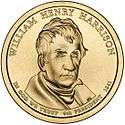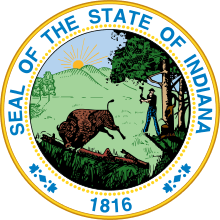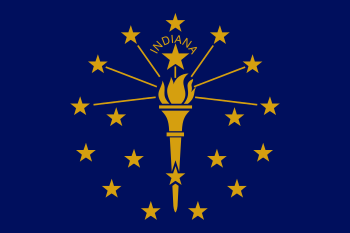William Henry Harrison
| Major General William Henry Harrison | |
|---|---|
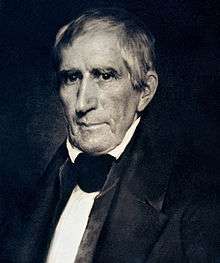 A daguerreotype of Harrison in 1841 | |
| 9th President of the United States | |
|
In office March 4, 1841 – April 4, 1841 | |
| Vice President | John Tyler |
| Preceded by | Martin Van Buren |
| Succeeded by | John Tyler |
| United States Minister to Gran Colombia | |
|
In office May 24, 1828 – September 26, 1829 | |
| Nominated by | John Quincy Adams |
| Preceded by | Beaufort Taylor Watts |
| Succeeded by | Thomas Patrick Moore |
| United States Senator from Ohio | |
|
In office March 4, 1825 – May 20, 1828 | |
| Preceded by | Ethan Allen Brown |
| Succeeded by | Jacob Burnet |
| Member of the U.S. House of Representatives from Ohio's 1st district | |
|
In office October 8, 1816 – March 3, 1819 | |
| Preceded by | John McLean |
| Succeeded by | Thomas R. Ross |
| Governor of the Indiana Territory | |
|
In office January 10, 1801 – December 28, 1812 | |
| Appointed by | John Adams |
| Preceded by | Position established |
| Succeeded by | Thomas Posey |
| Member of the U.S. House of Representatives from the Northwest Territory's At-large district | |
|
In office March 4, 1799 – May 14, 1800 | |
| Preceded by | Constituency established |
| Succeeded by | William McMillan |
| Secretary of the Northwest Territory | |
|
In office June 28, 1798 – October 1, 1799 | |
| Governor | Arthur St. Clair |
| Preceded by | Winthrop Sargent |
| Succeeded by | Charles Willing Byrd |
| Personal details | |
| Born |
February 9, 1773 Charles City County, Virginia, British America |
| Died |
April 4, 1841 (aged 68) Washington, D.C., U.S. |
| Resting place |
Harrison Tomb State Memorial North Bend, Ohio |
| Political party |
Democratic-Republican (1799–1828) Whig (1836–1841) |
| Spouse(s) | Anna Symmes (m. 1795; his death 1841) |
| Children | 10, including John Scott Harrison and Carter Bassett Harrison |
| Parents |
|
| Alma mater | |
| Profession | Military officer |
| Signature |
|
| Military service | |
| Allegiance |
|
| Service/branch | |
| Years of service | 1791–1798, 1811, 1812–1814 |
| Rank | Major General |
| Unit | Legion of the United States |
| Commands | Army of the Northwest |
| Battles/wars | |
William Henry Harrison Sr. (February 9, 1773 – April 4, 1841) was the ninth President of the United States (1841), an American military officer and politician, and the last president born as a British subject. He was also the first president to die in office. He was 68 years, 23 days old when inaugurated, the oldest president to take office until Ronald Reagan in 1981. Harrison died on his 32nd day in office[lower-alpha 1] of complications from pneumonia, serving the shortest tenure in United States presidential history. His death sparked a brief constitutional crisis, but its resolution left unsettled many questions following the presidential line of succession in regard to Constitution until the passage of the 25th Amendment in 1967. He was the grandfather of Benjamin Harrison, who served as the 23rd President from 1889 to 1893.
Before election as president, Harrison served as the first territorial congressional delegate from the Northwest Territory, as governor of the Indiana Territory, and later as a U.S. representative and senator from Ohio. He originally gained national fame for leading U.S. forces against American Indians at the Battle of Tippecanoe in 1811,[1] where he earned the nickname "Tippecanoe" (or "Old Tippecanoe"). As a general in the subsequent War of 1812, his most notable action was in the Battle of the Thames in 1813. This battle resulted in the death of Tecumseh and the dissolution of the Indian coalition which he led.[2]
After the war, Harrison moved to Ohio, where he was elected to the United States House of Representatives. In 1824, the state legislature elected him to the U.S. Senate. He served a truncated term after being appointed as Minister Plenipotentiary to Gran Colombia in May 1828. In Santa Fe de Bogotá, he spoke with president Simón Bolívar, urging his nation to adopt American-style democracy.
Returning to his farm in Ohio, Harrison lived in relative retirement until he was nominated for the presidency as one of several Whig Party candidates in the election of 1836. He received more votes than any other Whig, but was defeated by Democrat Martin Van Buren. He retired again to his farm.
Van Buren soon became a major target of criticism from the Whigs surrounding economic difficulties following the Panic of 1837. Seeking to run a non-controversial and less ideological war hero who could defeat Van Buren based on popularity, a unified Whig Party nominated Harrison over party founder Henry Clay and fellow general Winfield Scott. John Tyler of Virginia was selected as his running mate. Harrison and Tyler defeated Van Buren in the 1840 election. However, Harrison died of pneumonia in April 1841, a month after taking office. He had the shortest tenure of any president in history, and was the first president to die in office. Tyler then assumed all of the powers and duties of the president, setting a major precedent.
Early life
Early life and education
William Henry Harrison, the youngest of Benjamin Harrison V and Elizabeth Bassett Harrison's seven children, was born on February 9, 1773, at Berkeley Plantation, the Harrison family home in Charles City County, Virginia. Harrison was a member of a prominent political family of entirely English descent, whose ancestors had all been in Virginia since the 1630s.[3][4] Harrison was also the last U.S. president born as a British subject before American Revolution. Benjamin Harrison V, William's father, was a Virginia planter who served as a delegate to the Continental Congress (1774–1777) and signed the Declaration of Independence. The senior Harrison also served in the Virginia legislature as the fifth governor of Virginia (1781–84) in the years during and after the American Revolutionary War.[5][6][7] William's older brother, Carter Bassett Harrison, represented Virginia in the U.S. House (1793–99).[4][8]
Harrison was tutored at home before he entered Hampden–Sydney College, the Presbyterian school in Virginia in 1787 at the age of 14.[9] He remained at the school until 1790, receiving a classical education that included Latin, Greek, French, logic, and debate.[10][11] Harrison's Episcopalian father removed him from the college, possibly because of a religious revival that was occurring at the school. Harrison briefly attended a boys' academy in Southampton County, where he was allegedly influenced by antislavery Quakers and Methodists before his pro-slavery father had him transfer to Philadelphia for medical training in 1790. Harrison boarded with Robert Morris and entered the University of Pennsylvania, where he studied medicine under Doctor Benjamin Rush.[12] Harrison later told his biographer that he did not enjoy the subject. In the spring of 1791, shortly after he began his medical studies, Harrison's father died. When the eighteen-year-old Harrison, who was left in the guardianship of Morris, discovered that his family's financial situation left him without funds for further schooling, he abandoned medical school in favor of a military career.[11][13]
Early military career
Governor Henry Lee III of Virginia, a friend of Harrison's father, learned of William's situation and persuaded him to join the military. Within twenty-four hours of meeting Lee, eighteen-year-old Harrison was commissioned as an ensign in the U.S. Army, 1st Infantry Regiment. He was initially assigned to Fort Washington, the present-day site of Cincinnati, in the Northwest Territory, where the army was engaged in the ongoing Northwest Indian War.[14][15]
Harrison was promoted to lieutenant after Major General "Mad Anthony" Wayne took command of the western army in 1792 following a disastrous defeat under Arthur St. Clair, its previous commander. In 1793 Harrison became Wayne's aide-de-camp. Harrison learned how to successfully command an army on the American frontier and participated in Wayne's decisive victory at the Battle of Fallen Timbers on August 20, 1794, which brought the Northwest Indian War to a successful close for the United States.[14][16] Harrison was one of the signatories of the Treaty of Greenville (1795) as witness to Wayne, the principal negotiator for the U.S. government. Under the term of the treaty a coalition of Native Americans ceded a portion of their lands to the federal government that opened two-thirds of present-day Ohio to settlement by European Americans.[14][4][17][18]
Following the death of his mother in 1793, Harrison inherited a portion of his family's Virginia estate, including approximately 3,000 acres (12 km2) of land and several slaves. Harrison, who was serving in the army at the time, sold his land to his brother.[19]
Marriage and family
In 1795, at the age of 22, Harrison met Anna Tuthill Symmes of North Bend, Ohio. She was a daughter of Anna Tuthill and Judge John Cleves Symmes. Judge Symmes, who served as a colonel in the American Revolutionary War and as a representative to the Congress of the Confederation, became a prominent figure in Ohio.[4][20] When Harrison asked the judge for permission to marry Anna, he was refused. The pair waited until Symmes left on business, then they eloped and were married on November 25, 1795,[21] at the North Bend home of Doctor Stephen Wood, treasurer of the Northwest Territory. The couple honeymooned at Fort Washington, since Harrison was still on military duty. Two weeks later, at a farewell dinner for General Wayne, Judge Symmes confronted his new son-in-law for the first time since the wedding, sternly demanding to know how Harrison intended to support a family. Harrison responded, "by my sword, and my own right arm, sir."[22] Afterward, still concerned about Harrison's ability to provide for Anna, Judge Symmes sold the young couple 160 acres (65 ha) of land in North Bend.[23] Symmes did not come to accept Harrison until he had achieved fame on the battlefield.
William and Anna Harrison had ten children. Elizabeth Bassett (1796–1846), John Cleves Symmes (1798–1830), Lucy Singleton (1800–1826), William Henry (1802–1838), John Scott (1804–1878) father of future U.S. President Benjamin Harrison, Benjamin (1806-1840), Mary Symmes (1809–1842), Carter Bassett (1811–1839), Anna Tuthill (1813–1865), James Findlay (1814–1817).[24]
Anna, who was frequently in poor health during the marriage, primarily due to her many pregnancies, outlived William by twenty-three years. She died on February 25, 1864, at the age of eighty-eight.[10][25]
In a biography of Walter Francis White, the African-American civil rights leader and president of the National Association for the Advancement of Colored People in the mid-20th century, historian Kenneth Robert Janken notes that White's mother Madeline Harrison traced some of her mixed-race white ancestry to Harrison in Virginia. Her family holds that Dilsia, a female slave belonging to William Henry Harrison, had six children by him, born into slavery. Four were said to be sold to a planter in La Grange, Georgia, including a daughter, Marie Harrison. Marie was Madeline's mother.[26]
Political career
Harrison began the first phase of his political career when he resigned from the military effective June 1, 1798.[14][27] and campaigned among his friends and family for a post in the Northwest Territorial government. With the aid of his close friend Timothy Pickering, U.S. Secretary of State, Harrison received a recommendation to replace Withrop Sargent, the outgoing territorial secretary. President John Adams appointed Harrison to the position in July 1798. Harrison frequently served as acting territorial governor during the absences of Governor Arthur St. Clair.[14][28]
U.S. Congress
Harrison had many friends in the elite eastern social circles, and quickly gained a reputation among them as a frontier leader. He ran a successful horse-breeding enterprise that won him acclaim throughout the Northwest Territory. Harrison became a champion of lower land prices, a primary concern of settlers in the Territory at the time. The U.S. Congress had legislated a territorial land policy that led to high land costs, which many of the territory's residents disliked. In October 1799, after it had been determined that the Northwest Territory's population had reached a sufficient number to have an delegate in the U.S. Congress, Harrison ran for election.[29] He campaigned to work to alter the situation to encourage further migration to the territory, which would eventually lead to statehood.[30]
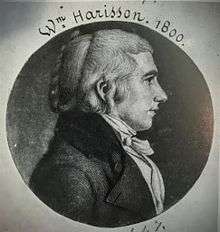
In 1799, at the age of twenty-six, Harrison defeated Arthur St. Clair Jr., the son of the territorial governor, by one vote to become the Northwest Territory's first congressional delegate. He served in the Sixth United States Congress from March 4, 1799, to May 14, 1800.[4][33] As the Northwest Territory's delegate to Congress, Harrison had no authority to vote on legislative bills, but he was permitted to serve on a committee, submit legislation, and engage in debate.[34]
Harrison became chairman of the Committee on Public Lands and successfully promoted the passage of the Land Act of 1800, which made it easier for the average settler to buy land in the Northwest Territory by allowing smaller tracts of land to be sold in a low cost. The sale price for public lands was set at $2 per acre.[35] The availability of inexpensive land for purchase was an important factor in the rapid population growth of the Northwest Territory.[36]
Harrison also served on the committee that decided how to divide the Northwest Territory into smaller sections. The committee recommended splitting the territory into two segments. The eastern section, which continued to be known as the Northwest Territory, comprised the present-day state of Ohio and eastern Michigan; the western section was name the Indiana Territory and consisted of the present-day states of Indiana, Illinois, Wisconsin, a portion of western Michigan, and the eastern portion of Minnesota.[35][37] The two new territories were formally established in 1800 following the passage of 2 Stat. 58.[38]
On May 13, 1800, President John Adams appointed Harrison as the governor of the newly-established Indiana Territory, based on his ties to the west and seemingly neutral political stances. Harrison, caught unaware, was reluctant to accept the position until he received assurances from the Jeffersonians that he would not be removed from office after they gained power in the upcoming elections.[39][40] After Harrison's governorship was confirmed by the U.S. Senate, he resigned from Congress to become the first Indiana territorial governor in 1801.[35][41]
Indiana territorial governor
Harrison arrived at Vincennes, the capital of the newly-established Indiana Territory on January 10, 1801, to begin his duties.[42] [43] U.S. presidents Thomas Jefferson and James Madison, both of whom were members of the Democratic-Republican Party, reappointed Harrison as the Indiana territorial governor in 1803, 1806, and 1809. Originally a Federalist Party appointee, Harrison was among the few to retain his post after Jefferson's and Madison's elections.[35] On December 28, 1812, Harrison resigned his position as territorial governor to continue his military career during the War of 1812.[44]
In 1804, while serving as the Indiana territorial governor, Harrison was assigned additional duties to administer the civilian government of the District of Louisiana, a part of the Louisiana Territory that included land north of the 33rd parallel. In October 1804, when a civilian government went into effect, Harrison served as the Louisiana district's executive leader. For a brief, five-week period, Harrison administered the district's affairs until the Louisiana Territory was formally established, effective July 4, 1805, and Brigadier General James Wilkinson assumed the duties of the Louisiana territorial governor.[45][46]
In 1805 Harrison built a plantation-style home near Vincennes that he named Grouseland, in reference to the birds on the property. The thirteen-room home was one of the first brick structures in the territory. During his term as territorial governor, Harrison's home served as a center of social and political life in the territory. The farm has been restored and is a popular, modern-day tourist attraction.[20][25] After the territorial capital was moved to Corydon in 1813, Harrison built a second home at nearby Harrison Valley.[47]
In addition to his duties as territorial governor, Harrison founded Jefferson University at Vincennes in 1801, The school was incorporated as Vincennes University on November 29, 1806, and is one of two U.S. colleges founded by a U.S. President; the other is the University of Virginia, which Thomas Jefferson founded.[48]
Governor Harrison had wide-ranging powers in the new territory, including the authority to appoint territorial officials and the territorial legislature, as well as control over division of the territory into smaller political districts and counties. One of his primary responsibilities was to obtain title to Indian lands that would allow future settlement and increase the territory's population, a requirement for statehood.[4] Harrison was eager to expand the territory for personal reasons as well; his political fortunes were tied to Indiana's eventual statehood. On February 8, 1803, when President Jefferson reappointed Harrison as the Indiana territorial governor, he also granted Harrison the authority to negotiate and conclude treaties with the Indians.[44]
Between 1803 and 1809, during his tenure as territorial governor, Harrison supervised eleven treaties with Indian leaders that provided the federal government with large tracts of land (more than 60,000,000 acres (240,000 km2)) that included the southern third of present-day Indiana and most of present-day Illinois for further settlement. The Treaty of St. Louis (1804) with Quashquame required the Sauk and Meskwaki to cede much of western Illinois and parts of Missouri to the federal government. Many of the Sauk, especially Black Hawk, greatly resented this treaty and the loss of lands, a primary reason the Sauk sided with the United Kingdom during the War of 1812. Harrison thought the Treaty of Grouseland (1805) appeased some of the Indians, but tensions remained high along the frontier. The Treaty of Fort Wayne (1809) raised new tensions when Harrison purchased land from the Miami tribe, who claimed ownership of the land, more than 2.5 million acres (10,000 km²) of land inhabited by the Shawnee, Kickapoo, Wea, and Piankeshaw peoples. Harrison rushed the treaty process by offering large subsidies to the tribes and their leaders so that the treaty would be in force before President Jefferson left office and the administration changed.[47][49] The tribes living on the ceded lands were furious and sought to have the treaty overturned, but were unsuccessful.
Although Harrison's pro-slavery position made him unpopular with the Indiana Territory's antislavery supporters, he used his political power to make several attempts to introduce slavery into the territory. His efforts were ultimately unsuccessful due to the territory's growing anti-slavery movement. In 1803, Harrison lobbied Congress to vote in favor of a petition to suspend Article VI of the Northwest Ordinance for ten years, a move that would allow slavery in the Indiana Territory. At the end of the suspension period citizens in the territories covered under the ordinance could decide for themselves whether to permit slavery. Harrison claimed the suspension was necessary to encourage make settlement and would make the territory economically viable, but Congress rejected the idea.[50] In 1803 and 1805 Harrison and the appointed territorial judges successfully enacted territorial laws that evaded the provisions outlined in Article VI of the Ordinance, authorized indentures, allowed slaves to be brought into the territory, and gave their masters the authority to determine the length of indentured servitude.[51][52] The pro-slavery laws caused a significant stir in the territory.
In 1809, after the separation of the western portion of the Indiana Territory to create the Illinois Territory, elections were held to select members of territorial legislature's upper and lower houses for the first time. (Previously, lower-house members were elected, but the territorial governor appointed members to the upper house.) Harrison found himself at odds with the legislature after the antislavery faction came to power and the eastern portion of the Indiana Territory grew to include a large, antislavery population.[53] When the Indiana Territory's general assembly convened in 1810, its antislavery faction immediately repealed the indenturing laws enacted in 1803 and in 1805.[46][54] After 1809 Harrison's political authority declined as the Indiana territorial legislature assumed more authority and the territory advanced toward statehood. By 1812 Harrison had moved away and resumed his military career.[55]
President Jefferson, the primary author of the Northwest Ordinance, had made a secret compact with James Lemen to defeat the proslavery movement led by Harrison. Although he was a slaveholder, Jefferson did not want slavery to expand into the Northwest Territory, as he believed the institution should eventually end. Under the "Jefferson-Lemen compact", Jefferson donated money to Lemen to found churches in Illinois and Indiana to stop the proslavery movement. In Indiana, the founding of an antislavery church led to citizens' signing a petition and organizing politically to defeat Harrison's efforts to legalize slavery in the territory. Jefferson and Lemen were both instrumental in defeating Harrison's attempts in 1805 and 1807 to secure approval to expand slavery in the territory.[56]
Army general
Tecumseh and Tippecanoe
An Indian resistance movement against U.S. expansion had been growing through the leadership of the Shawnee brothers, Tecumseh and Tenskwatawa (The Prophet). The conflict became known as Tecumseh's War. Tenskwatawa convinced the native tribes that they would be protected by the Great Spirit and no harm could befall them if they would rise up against the white settlers. He encouraged resistance by telling the tribes to pay white traders only half of what they owed and to give up all the white man's ways, including their clothing, muskets, and especially whiskey, which was becoming known as evil for American Indians.[57]

In August 1810, Tecumseh led 400 armed warriors down the Wabash River to meet with Harrison in Vincennes. As the warriors were dressed in war paint, their sudden appearance at first frightened the soldiers at Vincennes. The leaders of the group were escorted to Grouseland, where they met Harrison. Tecumseh insisted that the Fort Wayne Treaty was illegitimate. He argued that no one tribe could sell land without the approval of the other tribes; he asked Harrison to nullify it and warned that Americans should not attempt to settle the lands sold in the treaty. Tecumseh informed Harrison that he had threatened to kill the chiefs who signed the treaty if they carried out its terms, and that his confederation of tribes was growing rapidly.[58] Harrison said the Miami were the owners of the land and could sell it if they so chose. He rejected Tecumseh's claim that all the Indians formed one nation. He said each tribe could have separate relations with the United States if they chose to. Harrison argued that the Great Spirit would have made all the tribes speak one language if they were to be one nation.[59]
Tecumseh launched an "impassioned rebuttal", but Harrison was unable to understand his language.[59] A Shawnee friendly to Harrison cocked his pistol from the sidelines to alert Harrison that Tecumseh's speech was leading to trouble. Some witnesses reported that Tecumseh was encouraging the warriors to kill Harrison. Many of the warriors began to pull their weapons, representing a substantial threat to Harrison and the town, which held a population of only 1,000. Harrison pulled his sword. Tecumseh's warriors backed down after the officers had pulled their firearms in defense of Harrison.[59] Chief Winnemac, who was friendly to Harrison, countered Tecumseh's arguments and told the warriors that since they had come in peace, they should return home in peace. Before leaving, Tecumseh informed Harrison that unless the treaty were nullified, he would seek an alliance with the British.[60] After the meeting, Tecumseh journeyed to meet with many of the tribes in the region, hoping to create a confederation to battle the United States.[61]
In 1811, while Tecumseh was traveling, Harrison was authorized by Secretary of War William Eustis to march against the nascent confederation as a show of force. Harrison led an army of more than 1,000 men north to try to intimidate the Shawnee into making peace. Instead, the tribes launched a surprise attack on Harrison's army early on the morning of November 7, in what became known as the Battle of Tippecanoe. Harrison defeated the tribal forces at Prophetstown, next to the Wabash and Tippecanoe Rivers. Harrison was hailed as a national hero and the battle became famous. However, his troops had greatly outnumbered the attackers, and suffered many more casualties during the battle.[62]
When reporting to Secretary Eustis, Harrison informed him the battle occurred near the Tippecanoe River (which led to its naming), and he feared an imminent reprisal attack. The first dispatch did not make clear which side had won the conflict, and the secretary at first interpreted it as a defeat. The follow-up dispatch made the US victory clear. When no second attack came, the defeat of the Shawnee was more certain. Eustis demanded to know why Harrison had not taken adequate precautions in fortifying his camp against attacks. Harrison countered by saying he had considered the position strong enough. The dispute was the catalyst of a disagreement between Harrison and the Department of War that continued into the War of 1812.[63]
The press did not cover the battle at first, and one Ohio paper misinterpreted Harrison's dispatch to Eustis to mean he was defeated.[64] By December, as most major American papers carried stories on the battle, public outrage over the Shawnee attack grew. At a time of high tensions with the United Kingdom, many Americans blamed the British for inciting the tribes to violence and supplying them with firearms. In response, Congress passed resolutions condemning the British for interfering in American domestic affairs. A few months later, on June 18, 1812, the U.S. government declared war against United Kingdom.[65] Shortly thereafter, Harrison left Vincennes to seek a military appointment.[66]
War of 1812
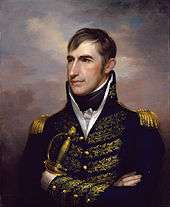
The outbreak of war with the British in 1812 led to continued conflict with Indians in the Old Northwest. Harrison briefly served as a major general in the Kentucky militia until the U.S. government commissioned him to command the Army of the Northwest on September 17, 1812. Although Harrison received federal military pay for his service, he also collected a territorial governor's salary from September until December 28, 1812, when he formally resigned as governor and continued his military service.[66]
After the American defeat in the Siege of Detroit, General James Winchester, who became the commander of the Army of the Northwest, offered Harrison the rank of brigadier general. Harrison also wanted sole command of the army. In September 1812, after President James Madison removed Winchester from command, Harrison became commander of the fresh recruits. Initially, the British and their Indian allies greatly outnumbered Harrison's troops. During the winter of 1812–13 Harrison constructed a defensive position along the Maumee River in northwest Ohio and named it Fort Meigs in honor of the Ohio governor Return J. Meigs Jr..
After receiving reinforcements in 1813, Harrison took the offensive and led the army north to battle the Shawnee and their British allies. Harrison won victories in the Indiana Territory and in Ohio and recaptured Detroit, before invading Upper Canada (present-day Ontario). Harrison's army defeated the British on October 5, 1813, at the Battle of the Thames, in which Tecumseh was killed.[66][67] This pivotal battle is considered to be one of the great American victories in the war, second only to the Battle of New Orleans.[67][68]
In 1814 U.S. Secretary of War John Armstrong divided the command of the army, assigning Harrison to a "backwater" post and giving control of the front to one of Harrison's subordinates. (Armstrong and Harrison had disagreed over the lack of coordination and effectiveness in the invasion of Canada.) In May, following Harrison's reassignment, he resigned from the arm; his resignation was accepted later that summer.[69][70] After the war ended, Congress investigated Harrison's resignation and determined that Armstrong had mistreated him during his military campaign and that his resignation was justified. Congress awarded Harrison a gold medal for his services during the War of 1812.
Following the defeat of the British and their Indian allies in western Canada, Harrison and Lewis Cass, governor of the Michigan Territory, were delegated the responsibility for negotiating a peace treaty with the Indians, known as the Treaty of Greenville (1814).[71] In June 1815, at President Madison's request, the U.S. government appointed Harrison to serve as one of the commissioners responsible for negotiating a second postwar treaty with the Indians that became known as the Treaty of Spring Wells (1815). Both treaties were advantageous to the United States. In the Spring Wells treaty the tribes ceded a large tract of land in the west, providing additional land for American purchase and settlement.[33][72]
Postwar life
After John Gibson replaced Harrison as Indiana territorial governor in 1812 and Harrison's resignation from the army in 1814, he returned to his family in North Bend. Harrison cultivated his land and enlarged the log cabin farmhouse, but he soon returned to public life.[73][74]
Public office
In 1816 Harrison was selected to complete the unexpired term of John McLean of Ohio in the U.S. House of Representatives, where Harrison represent the state from October 8, 1816, to March 4, 1819. In 1819 he was elected to the Ohio State Senate and served until 1821, having lost the election for Ohio governor in 1820. In 1822 he ran for a seat in the U.S. House, but lost by 500 votes to James W. Gazlay. In 1824 Harrison was elected to the U.S. Senate, where he served until May 20, 1828. Fellow westerners in Congress called Harrison a "Buckeye", a term of affection related to the native Ohio buckeye tree.[33] He was an Ohio presidential elector in 1820 for James Monroe[75] and an Ohio presidential elector in 1824 for Henry Clay.[76] In 1817 Harrison declined to serve as secretary of war under President Monroe.
Appointed as minister plenipotentiary to Gran Colombia, Harrison resigned from Congress and served in his new post until March 8, 1829.[33] He arrived in Bogotá on December 22, 1828. He found the condition of Colombia saddening. Harrison reported to the Secretary of State that the country was on the edge of anarchy and he thought Simón Bolívar was about to become a military dictator. While minister in Colombia, Harrison wrote a rebuke to Bolívar, stating "the strongest of all governments is that which is most free". He called on Bolívar to encourage the development of a democracy. In response, Bolívar wrote, "The United States ... seem destined by Providence to plague America with torments in the name of freedom", a sentiment that achieved fame in Latin America.[77] When the new administration of President Andrew Jackson took office in March 1829, Harrison was recalled so the new president could make his own appointment to the position. He returned to the United States in June.[78]
Private citizen
After Harrison returned to the United States from Colombia, he settled on his farm in North Bend, Ohio, his adopted home state. There, he lived in relative retirement after nearly 40 years of continuous government service. Having accumulated no substantial wealth during his lifetime, he subsisted on his savings, a small pension, and the income produced by his farm. Harrison cultivated corn and established a distillery to produce whiskey. After a brief time in the liquor business, he became disturbed by the effects of alcohol on its consumers, and closed the distillery. In a later address to the Hamilton County Agricultural Board in 1831, Harrison said he had sinned in making whiskey, and hoped that others would learn from his mistake and stop the production of liquors.[79]
In these early years, Harrison also earned money from his contributions to a biography written by James Hall, entitled A Memoir of the Public Services of William Henry Harrison, published in 1836. That year, he made an unsuccessful run for the presidency as a Whig candidate. Between 1836 and 1840, Harrison served as Clerk of Courts for Hamilton County. This was his job when he was elected president in 1840.[80] About this time, Harrison met African-American abolitionist and Underground Railroad conductor George DeBaptiste who lived in nearby Madison, Ohio. The two became friends, and DeBaptiste became his personal servant, staying with Harrison until his death[81] By 1840, when Harrison campaigned for president a second time, more than 12 books had been published on his life. He was hailed by many as a national hero.[82]
1836 presidential campaign
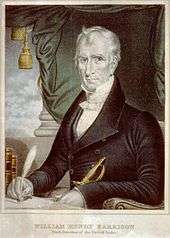
Harrison was the Northern Whig candidate for president in 1836, one of only two times in American history when a major political party intentionally ran more than one presidential candidate (the Democrats ran two candidates in 1860). Vice President Martin Van Buren, the Democratic candidate, was popular and deemed likely to win the election against an individual Whig candidate. The Whig plan was to elect popular Whigs regionally, deny Van Buren the 148 electoral votes needed for election, and force the House of Representatives to decide the election. They hoped the Whigs would control the House after the general elections. (This strategy would have failed, as the Democrats retained a majority in the House following the election.)[83][84]
Harrison ran in all the free states except Massachusetts, and the slave states of Delaware, Maryland, and Kentucky. Hugh L. White ran in the remaining slave states except for South Carolina. Daniel Webster ran in Massachusetts, and Willie P. Mangum in South Carolina.[85] The plan narrowly failed, as Van Buren won the election with 170 electoral votes. A swing of just over 4,000 votes in Pennsylvania would have given that state's 30 electoral votes to Harrison, and the election would have been decided in the House of Representatives.[83][84][86]
1840 presidential campaign
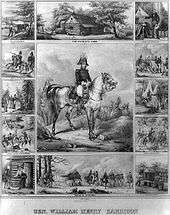
Harrison was the Whig candidate (and again faced Van Buren, now the incumbent president) in the 1840 election. The Whig party unified behind a single candidate, and Harrison was chosen over more controversial members of the party, such as Clay and Webster. Harrison based his campaign on his military record and on the weak U.S. economy, caused by the Panic of 1837. In a ploy to blame Van Buren for the depressed economy, the Whigs nicknamed him "Van Ruin".[87]
The Democrats ridiculed Harrison by calling him "Granny Harrison, the petticoat general", because he resigned from the army before the War of 1812 ended. When asking voters whether Harrison should be elected, the Democrats asked what Harrison's name spelled backwards would be: "No Sirrah". They also cast Harrison as a provincial, out-of-touch, old man who would rather "sit in his log cabin drinking hard cider" than attend to the administration of the country. This strategy backfired when Harrison and John Tyler, his vice presidential running mate, adopted the log cabin and hard cider as campaign symbols. Their campaign used the symbols on banners and posters, and created bottles of hard cider shaped like log cabins, all to connect to the candidates to the "common man".[88]
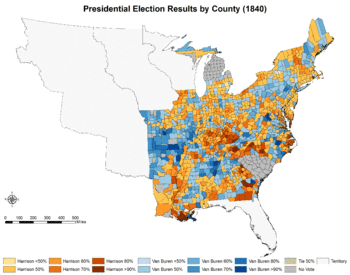
Although Harrison had come from a wealthy, slaveholding Virginia family, his campaign promoted him as a humble frontiersman in the style popularized by Andrew Jackson. In contrast, the Whigs presented Van Buren as a wealthy elitist. A memorable example was the Gold Spoon Oration that Pennsylvania's Whig representative, Charles Ogle, delivered in the U.S. House. The speech ridiculed Van Buren's elegant, White House lifestyle and lavish spending.[88][89][90] A Whig chant in which people would spit tobacco juice as they chanted "wirt-wirt," also exhibited the difference between candidates from the time of the election:[91]
Old Tip he wore a homespun coat, he had no ruffled shirt: wirt-wirt,
But Matt he has the golden plate, and he's a little squirt: wirt-wirt!
The Whigs also boasted of Harrison's military record and his reputation as the hero of the Battle of Tippecanoe. The campaign slogan, "Tippecanoe and Tyler, Too", became one of the most famous in American politics.[91] Harrison won a landslide victory in the Electoral College, 234 electoral votes to Van Buren's 60, although the popular vote was much closer. Harrison received 53 percent of the popular vote to Van Buren's 47 percent, with a margin of less than 150,000 votes.[91][92]
Presidency (1841)
Shortest presidency
_-_Portrait_of_William_Henry_Harrison.jpg)
When Harrison came to Washington, he wanted to show both that he was still the steadfast hero of Tippecanoe, and that he was a better educated and thoughtful man than the backwoods caricature ascribed to him in the campaign. He took the oath of office on March 4, 1841, a cold and wet day.[93] He wore neither an overcoat nor hat, rode on horseback to the ceremony rather than in the closed carriage that had been offered him, and delivered the longest inaugural address in American history.[93] At 8,445 words, it took him nearly two hours to read, although his friend and fellow Whig Daniel Webster had edited it for length. Harrison then rode through the streets in the inaugural parade,[94] and that evening attended three inaugural balls,[95] including one at Carusi's Saloon entitled the "Tippecanoe" ball, which at a price of US$10 per person (equal to $230 today) attracted 1000 guests.
The inaugural address was a detailed statement of the Whig agenda, essentially a repudiation of Jackson and Van Buren's policies. Harrison promised to reestablish the Bank of the United States and extend its capacity for credit by issuing paper currency (Henry Clay's American system); to defer to the judgment of Congress on legislative matters, with sparing use of his veto power; and to reverse Jackson's spoils system of executive patronage. He promised to use patronage to create a qualified staff, not to enhance his own standing in government.[96][97]
As leader of the Whigs and a powerful legislator (as well as a frustrated presidential candidate in his own right), Clay expected to have substantial influence in the Harrison administration. He ignored his own platform plank of overturning the "spoils" system. Clay attempted to influence Harrison's actions before and during his brief presidency, especially in putting forth his own preferences for Cabinet offices and other presidential appointments. Harrison rebuffed his aggression, saying "Mr. Clay, you forget that I am the President."[98] The dispute intensified when Harrison named Daniel Webster, Clay's arch-rival, for control of the Whig Party, as his Secretary of State, and appeared to give Webster's supporters some highly coveted patronage positions. Harrison's sole concession to Clay was to name his protégé John J. Crittenden to the post of Attorney General. Despite this, the dispute continued until the President's death.
Clay was not the only one who hoped to benefit from Harrison's election. Hordes of office applicants came to the White House, which was then open to all who wanted a meeting with the President. Most of Harrison's business during his month-long presidency involved extensive social obligations—an inevitable part of his high position and arrival in Washington—and receiving visitors at the White House. They awaited him at all hours and filled the Executive Mansion.[94] Harrison wrote in a letter dated March 10, "I am so much harassed by the multitude that call upon me that I can give no proper attention to any business of my own."[99] Nevertheless, Harrison sent a number of nominations for office to the Senate for confirmation during his month in office. The new 27th Congress had convened an extraordinary session for the purpose of confirming Harrison's cabinet and other important nominees; since a number of them arrived after Congress' March 15 adjournment, however, John Tyler would ultimately be forced to renominate many of Harrison's selections.
Harrison took his pledge to reform executive appointments very seriously, visiting each of the six executive departments to observe its operations and issuing through Webster an order to all departments that electioneering by employees would henceforth be considered grounds for dismissal.
BEP engraved portrait of Harrison as President.
[100] As he had with Clay, Harrison resisted pressure from other Whigs over partisan patronage. When a group arrived in his office on March 16 to demand the removal of all Democrats from any appointed office, Harrison proclaimed, "So help me God, I will resign my office before I can be guilty of such an iniquity!"[101] Harrison's own cabinet attempted to countermand the president's appointment of John Chambers as Governor of Iowa in favor of Webster's friend, General James Wilson; when Webster attempted to press this decision at a March 25 cabinet meeting, however, Harrison asked him to read aloud a handwritten note (which said simply "William Henry Harrison, President of the United States"), then announced that "William Henry Harrison, President of the United States, tells you, gentlemen, that, by God, John Chambers shall be governor of Iowa!"[102]
Harrison's only official act of consequence was to call Congress into a special session. Henry Clay and he had disagreed over the necessity of such a session, and when on March 11 Harrison's cabinet proved evenly divided, the president vetoed the idea. When Clay pressed Harrison on the special session on March 13, the president rebuffed his counsel and told him not to visit the White House again, but to address him only in writing.[103] A few days later, however, Treasury Secretary Thomas Ewing reported to Harrison that federal funds were in such trouble that the government could not continue to operate until Congress' regularly scheduled session in December; Harrison thus relented, and on March 17 proclaimed the special session in the interests of "the condition of the revenue and finance of the country". The session was scheduled to begin on May 31.[104][105]
Administration and cabinet
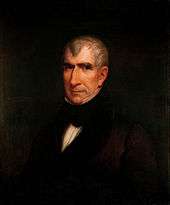
| The Harrison Cabinet | ||
|---|---|---|
| Office | Name | Term |
| President | William Henry Harrison | 1841 |
| Vice President | John Tyler | 1841 |
| Secretary of State | Daniel Webster | 1841 |
| Secretary of Treasury | Thomas Ewing | 1841 |
| Secretary of War | John Bell | 1841 |
| Attorney General | John J. Crittenden | 1841 |
| Postmaster General | Francis Granger | 1841 |
| Secretary of the Navy | George E. Badger | 1841 |
Death and funeral
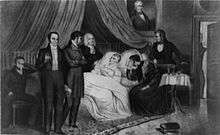
On March 26, 1841, Harrison became ill with a cold. According to the prevailing medical misconception of that time, his illness was believed to be caused by the bad weather at his inauguration; however, Harrison's illness did not arise until more than three weeks after the event.[107] The cold worsened, rapidly turning to pneumonia and pleurisy.[107] Harrison tried to rest in the White House, but could not find a quiet room because of the steady crowd of office seekers. His extremely busy social schedule also made rest time scarce.[94]
Harrison's doctors tried several cures, such as applying opium, castor oil, leeches, and Virginia snakeweed, but the treatments only made Harrison worse and he became delirious. He died nine days after becoming ill,[108] at 12:30 a.m. on April 4, 1841. Harrison's doctor, Thomas Miller, diagnosed Harrison's cause of death as "pneumonia of the lower lobe of the right lung." A medical analysis made in 2014 concluded that he instead died of enteric fever. (The authors of the 2014 study based their findings on the president's symptoms and the close proximity of the White House to a dumping ground for sewage and human waste.)[109][110]
Harrison became the first United States president to die in office. His last words were to his doctor, but it is assumed that they were directed at Vice President Tyler: "Sir, I wish you to understand the true principles of the government. I wish them carried out. I ask nothing more." Harrison served the shortest term of any American president: March 4 – April 4, 1841, 30 days, 12 hours, and 30 minutes.[111][112]
Harrison's funeral took place in the Wesley Chapel in Cincinnati, Ohio, on April 7, 1841.[113] His original interment was in the public vault of the Congressional Cemetery in Washington, D.C., but his remains were later buried in North Bend, Ohio. The William Henry Harrison Tomb State Memorial was erected at the gravesite in his honor.[114]
Impact of death
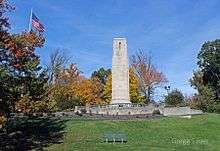
Harrison's death was a disappointment to Whigs, who hoped to pass a revenue tariff and enact measures to support Henry Clay's American system. John Tyler, Harrison's successor and a former Democrat, abandoned the Whig agenda, effectively cutting himself off from the party.[115]
Due to the death of Harrison, three Presidents served within a single calendar year (Martin Van Buren, Harrison, Tyler). This has happened on only one other occasion, 40 years later in 1881, when Rutherford B. Hayes was succeeded by James A. Garfield, who was assassinated later in that year. With the death of Garfield, Chester A. Arthur stepped into the presidency.[116]
Harrison's death revealed the flaws in the U.S. Constitution's clauses on presidential succession.[117] Article II of the Constitution states: "In Case of the Removal of the President from Office, or of his Death, Resignation, or Inability to discharge the Powers and Duties of the said Office, the Same shall devolve on the Vice President ... and [the Vice President] shall act accordingly, until the Disability be removed, or a President shall be elected".[118] Scholars at the time disagreed whether the vice president would become president or merely acting President. The Constitution did not stipulate whether the Vice President could serve the remainder of the President's term, until the next election, or if emergency elections should be held.
Harrison's cabinet insisted that Tyler was "Vice President acting as President". After the cabinet consulted with the Chief Justice Roger Taney, they decided that if Tyler took the presidential Oath of Office, he would assume the office of President. Tyler obliged and was sworn into office on April 6, 1841. Congress convened in May, and after a short period of debate in both houses, it passed a resolution that confirmed Tyler as president for the remainder of Harrison's term. Once established, this precedent of presidential succession remained in effect until the Twenty-fifth Amendment was ratified in 1967,[115][119] following the assassination of John F. Kennedy and the succession of Lyndon B. Johnson to the presidency in 1963. The Twenty-fifth Amendment dealt with the finer points of succession, defining the situations in which the vice president would serve as acting president, and in which situations the vice president could become president.[120]
Legacy
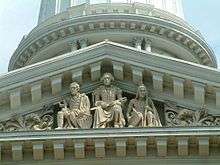
Among Harrison's most enduring legacies is the series of treaties that he either negotiated or signed with Native American leaders during his tenure as the Indiana territorial governor.[10] As part of the treaty negotiations, the native tribes ceded large tracts of land in the west that provided additional acreage for purchase and settlement.[33][121][72] Harrison's chief presidential legacy lies in his campaigning methods, which laid the foundation for the modern presidential campaign tactics.[122]
Harrison was the first sitting President to have his photograph taken. The image was made in Washington, D.C., on his inauguration day in 1841. Photographs exist of John Quincy Adams, Andrew Jackson, and Martin van Buren, but the images were taken after the men were no longer president. The Harrison image was also the first presidential photograph. The original daguerreotype of Harrison on his inauguration day has been lost—although at least one early photographic copy exists in the archives of the Metropolitan Museum of Art.[123]
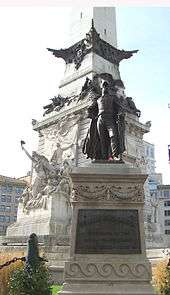
Harrison died nearly penniless. Congress voted in favor of providing his wife, Anna, a presidential widow's pension of $25,000,[124] one year of Harrison's salary. (Equivalent to $574,435 in today's dollars.) She also received the right to mail letters free of charge.[125]
Harrison's son, John Scott Harrison, represented Ohio in the U.S. House of Representatives between 1853 and 1857.[126] Harrison's grandson, Benjamin Harrison of Indiana, served as the twenty-third U.S. president from 1889 to 1893, making William and Benjamin Harrison the only grandparent–grandchild pair of U.S. presidents.[127]
Honors and tributes

Harrison's likeness appears on the following U.S. Postal Service postage stamps:
- 9-cent postage stamp issue,1938
- 3-cent Indiana Territory Sesquicentennial commemorative stamp issue, 1950
- AMERIPEX presidential commemorative stamp issue, 1986
On February 19, 2009, the U.S. Mint released the ninth coin in the Presidential $1 Coin Program, bearing Harrison's likeness. A total of 98,420,000 coins were minted.[128][129]
The following monuments and memorial statues have been erected in tribute to Harrison:
- A bronze statue of Harrison is one of several erected on Monument Circle, surrounding the Soldiers' and Sailors' Monument in downtown Indianapolis. John H. Mahoney received the commission to create the Harrison statue in 1895; it was completed in 1899.[130]
- A statue of Harrison is a part of a granite monument erected in 1908 to commemorate the Battle of Tippecanoe, which took place near the present-day town of Battle Ground, Indiana, in Tippecanoe County.[131]
- A limestone statue of Harrison in civilian attire, created by Harold "Dugan" Elgar, was initially erected in 1972 on the campus of Vincennes University in Vincennes, Indiana; however, the statue was damaged and placed in storage until 2002, when it was erected in front of the school's Matthew Welsh Administration building.[132]
- A limestone-relief carving of Harrison by Larry Beisler is included as part of a public sculpture installed in front of the Harrison County, Indiana, visitors' center. The sculpture was dedicated in 2001.[133]
- The Ten O'Clock Line Monument by sculptor Frederick L. Hollis in Owen County, Indiana, commemorates a treaty signed in 1809. Harrison is one of the two central figures in the limestone monument, which was completed in 1957; the other figure depicts Chief Little Turtle of the Miami people.[134]
- Harrison is one of three figures depitcted in the north and south pediments of the Tippecanoe County Courthouse in Lafayette, Indiana; the other two figures in the pediments depict Tecumseh and the Marquis de Lafayette.[135]
- A bronze statue of a uniformed General Harrison on horseback was dedicated in 1896 in Cincinnati's Piatt Park.Louis T. Rebisso of the Cincinnati School of Design and his student, Clement Barnhorn, created the work. "Ohio's First President" is inscribed on the north side of the pedestal; the south side includes an inscription of his name. The statue, which is notable for being the only equestrian monument in Cincinnati, is unusual because there is no saddle on the horse, so the stirrups appear to be airborne. One of the horse's legs is raised to indicate that the rider was wounded in battle.[136] The monument originally faced east, toward Vine Street, but it was moved in 1988 to its present location facing west, toward the Covenant First Presbyterian Church across Elm Street.[137]
Numerous places have been named in Harrison's honor:
- Harrison, Michigan
- Harrison, New Jersey
- Harrison, Ohio[138]
- Tipp City, Ohio (formerly Tippecanoe City)[138][139]
- Tippecanoe, Ohio[138]
- Harrison, Tennessee
- Harrison County, Indiana
- Harrison County, Mississippi
- Harrison County, Iowa
- Harrison County, Ohio
- At least three schools have been named in Harrison's honor: William Henry Harrison High School in Evansville[140] and West Lafayette, Indiana,[141] and Harrison, Ohio).[142]
- William Henry Harrison Park in Pemberville, Ohio,[143] was near the site of one of General Harrison's Northwestern Army military encampments during the War of 1812.[144]
- Camp Harrison was a Union army military post near Cincinnati during the American Civil War[145]
- Fort William Henry Harrison, a military fort in Montana, was initially named Fort Harrison in 1892 to honor President Benjamin Harrison, the twenty-third president, but the fort was renamed in 1906 as a tribute to William Henry Harrison, the ninth president, after it was discovered that a U.S. Army fort in Indianapolis had already been named in honor of Benjamin Harrison.[146]
Harrison is one of nineteen U.S. presidents with no military vessel named after them.[147]
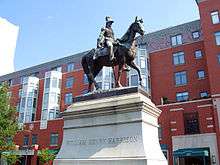
In popular culture
- James Seay portrays Harrison in the 1952 Technicolor western film, Brave Warrior, which is based on events of the War of 1812 and the Battle of Tippecanoe. Jay Silverheels, best known for his role as Tonto in the popular television series, The Lone Ranger, portrays Tecumseh, Harrison's adversary.[148]
- DEFA, the state-owned East German studio released the red western film, Tecumseh, in 1972, with Wolfgang Greese in the role of Governor Harrison.[149]
- Tecumseh!, an outdoor stage drama, has been running since 1973 near Chillicothe, Ohio, at the Sugarloaf Mountain Amphitheatre. Allan W. Eckert, a novelist/historian and a seven-time Pulitzer Prize nominee and an Emmy recipient, wrote the play, which centers on the life of Tecumseh and depicts interactions between the Shawnee leader and Harrison in the early nineteenth century.[150]
- In "I Love Lisa", season 4, episode 15, of the animated television series, The Simpsons, "The Mediocre President's Song," which is delivered in a Springfield Elementary School Presidents Day children's pageant, refers to Harrison. One of the children portraying Harrison boasts, "I died in 30 days!"
- Tecumseh: The Last Warrior, a 1995 TNT Network film about Tecumseh's life, is based on James Alexander Thom's book, Panther in the Sky. The documentary was produced, in part, by Francis Ford Coppola; it was filmed near Winston-Salem, North Carolina. David Clennon portrays Harrison.[151][152]
- Dwier Brown, best known for his role in the 1989 film, Field of Dreams, portrays Harrison in "Tecumseh's Vision", episode 2 of the PBS mini-series documentary, We Shall Remain (2009).[153]
- Volume II of the presidential Pez candy dispenser series, released in November 2012, includes dispensers depicting the sixth through tenth U.S. Presidents (John Quincy Adams, Andrew Jackson, Martin Van Buren, Harrison, and John Tyler) and a six-pack of candy. The Harrison dispenser is the only one in the series that can be purchased individually; it is sold through the Grouseland Foundation[154]
- On January 20, 2015, the American television sitcom, Parks and Recreation, aired "William Henry Harrison" (season 7, episode 3), which centers on a visit to a fictionalized version of the William Henry Harrison Museum at Grouseland. The included a reproduction of the tin ball used in Harrison's 1840 presidential campaign that inspired the idiom, "keep the ball rolling"[155]
See also
- Curse of Tippecanoe
- List of Governors of Indiana
- List of Presidents of the United States
- List of Presidents of the United States by previous experience
- List of Presidents of the United States who died in office
- U.S. presidents on U.S. postage stamps
Notes
- ↑ Harrison served as president for 30 days, 12 hours and 32 minutes, but this was spread over 32 different calendar days; part of a day upon inauguration, 30 full days, then part of the day on which he died.
References
Citations
- ↑ Buescher, John. "Tippecanoe and Walking Canes Too". TeachingHistory.org. Retrieved 8 October 2011.
- ↑ Langguth, A. J. (2006). Union 1812:The Americans Who Fought the Second War of Independence, New York: Simon & Schuster. ISBN 0-7432-2618-6. p. 206
- ↑ Nelson, Lyle Emerson. American Presidents Year by Year. I. p. 30.
- 1 2 3 4 5 6 "William Henry Harrison Biography". About The White House: Presidents. whitehouse.gov. Retrieved June 19, 2008.
- ↑ Owens 2007, p. 3.
- ↑ Smith, Howard; Riley, Edward M., eds. (1978). Benjamin Harrison and the American Revolution. Virginia in the Revolution. Williamsburg, VA: Virginia Independence Bicentennial Commission. pp. 59–65. OCLC 4781472.
- ↑ Barnhart & Riker 1971, p. 315.
- ↑ "Carter Bassett Harrison". Biographical Directory of the United States Congress. U.S. Congress. Retrieved September 14, 2016.
- ↑ Freehling, William. "William Henry Harrison: Life Before the Presidency". American President: An Online Reference Resource. University of Virginia. Retrieved December 10, 2010.
The boy enjoyed a solid education—tutored at home, then three years at Hampden-Sydney College in Hanover County, Virginia.
- 1 2 3 Gugin & St. Clair 2006, p. 18.
- 1 2 Madison & Sandweiss 2014, p. 45.
- ↑ Owens 2007, p. 14.
- ↑ Langguth 2007, p. 16.
- 1 2 3 4 5 Gugin & St. Clair 2006, p. 19.
- ↑ Owens 2007, pp. 14, 22.
- ↑ Owens 2007, p. 27.
- ↑ Langguth 2007, p. 160.
- ↑ Owens 2007, pp. 21, 27–29.
- ↑ Owens 2007, p. 39.
- 1 2 Madison & Sandweiss 2014, p. 46.
- ↑ Owens 2007, pp. 38–39.
- ↑ Bob Dole, Great Presidential Wit, 2001, page 222
- ↑ Owens 2007, p. 40.
- ↑ "American President—Miller Center". millercenter.org. Retrieved 2016-10-25.
- 1 2 Owens 2007, p. 56.
- ↑ Janken, Kenneth Robert (2006). Walter White: Mr. NAACP. Chapel Hill: UNC Press. pp. 3–4.
- ↑ "Historical register and dictionary of the United States Army : from its organization, September 29, 1789, to March 2, 1903". archive.org.
- ↑ Green 2007, p. 9.
- ↑ Gugin & St. Clair 2006, pp. 19–20.
- ↑ Owens 2007, pp. 41–45.
- ↑ de, saint-mémin, charles balthazar julien fevret. "[William Henry Harrison, 9th Pres. of United States, head-and-shoulders portrait, right profile]". Retrieved 2016-08-05.
- ↑ "National Park Service - The Presidents (William Henry Harrison)". www.nps.gov. Retrieved 2016-08-05.
- 1 2 3 4 5 "Harrison, William Henry, (1773–1841)". Biographical Directory of the United States Congress. Retrieved February 4, 2009.
- ↑ Owens 2007, pp. 45–46.
- 1 2 3 4 Gugin & St. Clair 2006, p. 20.
- ↑ Langguth 2007, p. 161.
- ↑ Owens 2007, pp. 49, 50, 54.
- ↑ Owens 2007, pp. 47–48.
- ↑ Owens 2007, p. 51.
- ↑ Barnhart & Riker 1971, p. 314.
- ↑ Owens 2007, p. 50–53.
- ↑ Owens 2007, p. 53.
- ↑ Barnhart & Riker 1971, p. 323.
- 1 2 Gugin & St. Clair 2006, pp. 20, 23.
- ↑ Barnhart & Riker 1971, p. 343.
- 1 2 Gugin & St. Clair 2006, p. 21.
- 1 2 Funk 1969, p. 167.
- ↑ "History - Vincennes University". www.vinu.edu. Retrieved 2016-07-29.
- ↑ Owens 2007, pp. 65–66, 79, 80, 92.
- ↑ Owens 2007, pp. 68–69.
- ↑ Owens 2007, pp. 69–72.
- ↑ Barnhart & Riker 1971, p. 347.
- ↑ Barnhart & Riker 1971, p. 355.
- ↑ Owens 2007, pp. 179–180.
- ↑ Gugin & St. Clair 2006, pp. 22–23.
- ↑ Peck, J. M. (June 4, 1851). The Jefferson-Lemen Compact. Retrieved March 28, 2010.
- ↑ Langguth 2007, pp. 158–160.
- ↑ Langguth 2007, p. 164.
- 1 2 3 Langguth 2007, p. 165.
- ↑ Langguth 2007, p. 166.
- ↑ Langguth 2007, pp. 164–169.
- ↑ Langguth 2007, pp. 167–169.
- ↑ Owens 2007, pp. 219–220.
- ↑ Owens 2007, p. 220.
- ↑ Owens 2007, pp. 221, 223.
- 1 2 3 Gugin & St. Clair 2006, p. 23.
- 1 2 Langguth 2007, pp. 268–70.
- ↑ Langguth 2007, pp. 291–92.
- ↑ Langguth 2007, pp. 291–292.
- ↑ Gugin & St. Clair 2006, p. 24.
- ↑ Barnhart & Riker 1971, pp. 407–08.
- 1 2 Barnhart & Riker 1971, pp. 409–10.
- ↑ Milligan, Fred (2003). Ohio's Founding Fathers. iUniverse, Inc. pp. 107–08.
- ↑ Gugin & St. Clair 2006, p. 30.
- ↑ Taylor & Taylor 1899, p. 102.
- ↑ Taylor & Taylor 1899, p. 145.
- ↑ Bolívar 1951, p. 732.
- ↑ Hall 1836, pp. 301–309.
- ↑ Burr 1840, p. 258.
- ↑ "Patricia M. Clancy – Clerk of Courts: History of the Clerk of Courts Office". Courtclerk.org. Retrieved 2011-12-06.
- ↑ Tobin, Jacqueline L. From Midnight to Dawn: The Last Tracks of the Underground Railroad. Anchor, 2008. p200-209
- ↑ Burr 1840, p. 257-58.
- 1 2 United States Congress (1837). Senate Journal. 24th Congress, 2nd Session, February 4. pp. 203–204. Retrieved August 20, 2006.
- 1 2 Shepperd, Michael. "How Close Were The Presidential Elections? 1836". Michigan State University. Retrieved February 11, 2009.
- ↑ Lorant, Stefan (1953). The Presidency. New York: The Macmillan Company.
- ↑ "Historical Election Results". National Archives. Retrieved June 20, 2008.
- ↑ Carnes & Mieczkowski 2001, p. 39.
- 1 2 Carnes & Mieczkowski 2001, pp. 39–40.
- ↑ "The Time Machine: 1840, One Hundred And Fifty Years Ago". American Heritage. April 1990. Retrieved September 21, 2016.
- ↑ Bradley, Elizabeth L. Knickerbocker: The Myth behind New York. New Brusnwick, NJ: Rivergate Books. pp. 70–71. ISBN 978-0-8135-4516-5.
- 1 2 3 Carnes & Mieczkowski 2001, p. 41.
- ↑ Gugin & St. Clair 2006, p. 25.
- 1 2 "Harrison's Inauguration". American Treasures of the Library of Congress. Retrieved 2009-01-21.
- 1 2 3 "Harrison's Inauguration (Reason): American Treasures of the Library of Congress". Library of Congress. Retrieved June 9, 2008.
- ↑ United States Senate (June 10, 2013). "Inaugural Ball". inaugural.senate.gov.
- ↑ "William Henry Harrison Inaugural Address". Inaugural Addresses of the Presidents of the United States. Bartleby.com. 1989. Retrieved February 11, 2009.
- ↑ ""I Do Solemnly Swear ...": Presidential Inaugurations". Library of Congress. Retrieved February 11, 2009.
- ↑ Borneman 2005, p. 56.
- ↑ http://www.shapell.org/manuscript.aspx?175070 Letter from Harrison to R. Buchanan, Esq., March 10, 1841
- ↑ http://aprg.web.unc.edu/files/2011/10/Michael-Gerhardt-APRG.pdf
- ↑ Woollen, William Wesley (1975). Biographical and historical sketches of early Indiana. Ayer Publishing. p. 51. ISBN 978-0-405-06896-6.
- ↑ Remini, Robert (1997). Daniel Webster: The Man and His Time. W.W. Norton & Company. pp. 520–21.
- ↑ "American History Series: The Brief Presidency of William Henry Harrison". Voice of America News. Retrieved June 21, 2009.
- ↑ Brinkley, Alan; Dyer, Davis (2004). The American Presidency. Houghton Mifflin. ISBN 978-0-618-38273-6. Retrieved June 21, 2009.
- ↑ "Harrison's Proclamation for Special Session of Congress" (PDF). Archived from the original (PDF) on 2011-07-24. Retrieved June 21, 2009.
- ↑ "Official Portraits of the U.S. Presidents". The White House. Retrieved 2016-07-29.
- 1 2 Cleaves 1939, p. 152.
- ↑ Cleaves 1939, p. 160.
- ↑ McHugh, Jane; Mackowiak, Philip A. (March 31, 2014). "What Really Killed William Henry Harrison?". The New York Times. Retrieved August 27, 2014.
- ↑ McHugh, Jane; Mackowiak, Philip A. (June 23, 2014). "Death in the White House: President William Henry Harrison's Atypical Pneumonia". Clinical Infectious Diseases. 59 (7): 990–5. doi:10.1093/cid/ciu470. PMID 24962997.
- ↑ "President Harrison Dies – April 4, 1841". Events in Presidential History. Miller Center, University of Virginia. 2008. Retrieved February 16, 2009.
- ↑ ed.: Robert A. Diamond ... Major contributors: Rhodes Cook ... (1976). Congressional Quarterly's Guide to U.S. Elections. Congressional Quarterly Inc. p. 492. ISBN 978-0-87187-072-8.
- ↑ ""Presidential Funerals" – White House History". whha.org.
- ↑ "Harrison Tomb". Ohio Historical Society. Retrieved June 9, 2008.
- 1 2 "John Tyler, Tenth Vice President (1841)". senate.gov. Retrieved June 18, 2008.
- ↑ Kelly, Martin. "Tecumseh's Curse and the US Presidents: Coincidence or Something More?". About.com. Retrieved June 9, 2008.
- ↑ "United States Constitution, Article II". Cornell University Law School. Retrieved February 11, 2009.
- ↑ "The Constitution of the United States: A Transcription". U.S. National Archives and Records Administration. Retrieved September 19, 2016.
- ↑ "United States Constitution, Amendment XXV". Cornell University Law School. Retrieved February 11, 2009.
- ↑ "The Constitution: Amendments 11-27". U.S. National Archives and Records Administration. Retrieved September 19, 2016.
- ↑ Madison & Sandweiss 2014, p. 47.
- ↑ Green 2007, p. 100.
- ↑ "The Met Collection Database". Metropolitan Museum of Art. Retrieved December 12, 2008.
- ↑ Damon, Allan L. (June 1974). "Presidential Expenses". American Heritage. 25 (4). Retrieved February 10, 2009.
- ↑ "First Lady Biography: Anna Harrison". First Ladies. 2009. Retrieved February 11, 2009.
- ↑ "Harrison, John Scott, (1804–1878)". Biographical Directory of the United States Congress. Retrieved June 18, 2008.
- ↑ Calhoun 2005, pp. 43–49.
- ↑ "The United States Mint Coins and Medals Program". www.usmint.gov. Retrieved 2016-07-28.
- ↑ "Circulating Coins Production Figures: usmint.gov". www.usmint.gov. Retrieved 2016-07-28.
- ↑ Greiff 2005, pp. 12, 164.
- ↑ Greiff 2005, pp. 22, 241.
- ↑ Greiff 2005, pp. 26–27; 143–44.
- ↑ Greiff 2005, p. 131.
- ↑ Greiff 2005, p. 206.
- ↑ Greiff 2005, p. 243.
- ↑ "Piatt Park was city's first". Retrieved 2016-07-28.
- ↑ "Statue of William Henry Harrison - Cincinnati, Ohio - American Guide Series on Waymarking.com". www.waymarking.com. Retrieved 2016-07-28.
- 1 2 3 Overman, William Daniel. Ohio towns names. Akron, Ohio.
- ↑ "History & Photos". VisitTippCity.org. Retrieved 2016-07-28.
- ↑ "William Henry Harrison High School". William Henry Harrison High School, Evansville, IN. 2009. Retrieved February 6, 2009.
- ↑ "William Henry Harrison High School". William Henry Harrison High School, West Layfayette, IN. 2009. Retrieved February 6, 2009.
- ↑ "William Henry Harrison High School". William Henry Harrison High School, Harrison, OH. 2009. Archived from the original on July 22, 2006. Retrieved February 6, 2009.
- ↑ "William Henry Harrison Park". Retrieved September 15, 2016.
- ↑ "Remarkable Ohio". Ohio History Connection. Retrieved September 15, 2016.
- ↑ "Camp Harrison". Ohio History Central. July 1, 2005. Retrieved June 18, 2008.
- ↑ "Montana's Military Museum: Fort Harrison Complex, Helena, Montana". Montana Army National Guard. 2008. Retrieved January 21, 2009.
- ↑ Pike, John. "Ships Named After Presidents". www.globalsecurity.org. Retrieved 2016-08-05.
- ↑ Bennet, Spencer Gordon (1952-06-01), Brave Warrior, retrieved 2016-08-04
- ↑ Kratzert, Hans (1972-07-01), Tecumseh, retrieved 2016-08-04
- ↑ "'Tecumseh!' cast and crew work, play hard". Retrieved 2016-08-15.
- ↑ Elikann, Larry (1995-06-04), Tecumseh: The Last Warrior, retrieved 2016-08-04
- ↑ Scott, Tony (1995-06-02). "Review: 'Tnt Original Tecumseh: The Last Warrior'". Retrieved 2016-08-04.
- ↑ "We Shall Remain: Behind the Scenes: Meet the Cast & Crew, "Tecumseh's Vision," Episode 2". American Experience, PBS. Retrieved 2016-07-29.
- ↑ "William Henry Harrisons Grouseland". Grouseland Foundation. Retrieved 2016-07-29.
- ↑ "Presidential Campaigns: A Cartoon History 1789-1976". Indiana University. Retrieved 2016-07-29.
Bibliography
- Barnhart, John D.; Riker, Dorothy L., eds. (1971). Indiana to 1816: The Colonial Period. The History of Indiana. I. Indianapolis: Indiana Historical Bureau and the Indiana Historical Society.
- Bolívar, Simón (1951). Bierck, Harold A. Jr., ed. Selected Writings of Bolívar. II. New York: Colonial Press. ISBN 978-1-60635-115-4. compiled by Lecuna, Vicente, translated by Bertrand, Lewis
- Borneman, Walter R. (2005). 1812: The War That Forged a Nation. New York: HarperCollins (Harper Perennial). ISBN 978-0-06-053113-3.
- Burr, Samuel Jones (1840). The Life and Times of William Henry Harrison. New York: R. W. Pomeroy. Retrieved September 14, 2016.
- Calhoun, Charles William (2005). Benjamin Harrison: The 23rd President 1889–1893. The American Presidents. 23. New York: Macmillan. ISBN 978-0-8050-6952-5.
- Carnes, Mark C.; Mieczkowski, Yanek (2001). The Routledge Historical Atlas of Presidential Campaigns. Routledge Atlases of American History. New York: Routledge. ISBN 978-0-415-92139-8.
- Cleaves, Freeman (1939). Old Tippecanoe: William Henry Harrison and His Time. New York: C. Scribner's Sons.
- Funk, Arville (1969). A Sketchbook of Indiana History. Rochester, Indiana: Christian Book Press.
- Green, Meg (2007). William H. Harrison. Breckenridge, Colorado: Twenty-First Century Books. ISBN 978-0-8225-1511-1.; for children
- Greiff, Glory-June (2005). Remembrance, Faith and Fancy: Outdoor Public Sculpture in Indiana. Indianapolis: Indiana Historical Society Press. ISBN 0-87195-180-0.
- Gugin, Linda C.; St. Clair, James E., eds. (2006). The Governors of Indiana. Indianapolis: Indiana Historical Society Press and the Indiana Historical Bureau. ISBN 0-87195-196-7.
- Hall, James (1836). A Memoir of the Public Services of William Henry Harrison, of Ohio. Philadelphia, Pennsylvania: Key & Biddle. Retrieved September 14, 2016.
- Langguth, A. J. (2007). Union 1812: The Americans Who Fought the Second War of Independence. New York: Simon & Schuster. ISBN 978-1-4165-3278-1.
- Madison, James H.; Sandweiss, Lee Ann (2014). Hoosiers and the American Story. Indianapolis: Indiana Historical Society Press. ISBN 978-0-87195-363-6.
- Owens, Robert M. (2007). Mr. Jefferson's Hammer: William Henry Harrison and the Origins of American Indian Policy. Norman, Oklahoma: University of Oklahoma Press. ISBN 978-0-8061-3842-8.
- Taylor, William Alexander; Taylor, Aubrey Clarence (1899). Ohio statesmen and annals of progress: from the year 1788 to the year 1900 ... 1. State of Ohio.
Further reading
- Booraem, Hendrik (2012). A Child of the Revolution: William Henry Harrison and His World, 1773–1798. Kent State University Press.
- Jortner, Adam (2012). The Gods of Prophetstown: The Battle of Tippecanoe and the Holy War for the American Frontier. Oxford University Press. ISBN 978-0-19-976529-4.
- Pirtle, Alfred. (1900). The Battle of Tippecanoe. Louisville: John P. Morton & Co./ Library Reprints. p. 158. ISBN 978-0-7222-6509-3. as read to the Filson Club.
- Shade, William G. "'Tippecanoe and Tyler too': William Henry Harrison and the rise of popular politics." in Joel H. Silbey, ed., A Companion to the Antebellum Presidents 1837–1861 (2013) pp: 155–72.
- Skaggs, David Curtis. William Henry Harrison and the Conquest of the Ohio Country: Frontier Fighting in the War of 1812 (Johns Hopkins University Press, 2014) xxii.
External links
- United States Congress. "William Henry Harrison (id: H000279)". Biographical Directory of the United States Congress.
- William H. Harrison at Ohio History Central
- Papers of William Henry Harrison, 1800–1815, Collection Guide, Indiana Historical Society
- Announcement of William Henry Harrison Impending Death
- William Henry Harrison ALS, March 10, 1841: Harassed by the Multitudes
- William Henry Harrison's Personal Correspondence While in Office Shapell Manuscript Foundation
- Essays on Harrison, each member of his cabinet and First Lady
- William Henry Harrison Biography and Fact File
- Biography by Appleton's and Stanley L. Klos
- William Henry Harrison: Young Tippecanoe
- Inaugural Address, via Wikisource
- "Life Portrait of William Henry Harrison", from C-SPAN's American Presidents: Life Portraits, May 10, 1999
.jpg)
